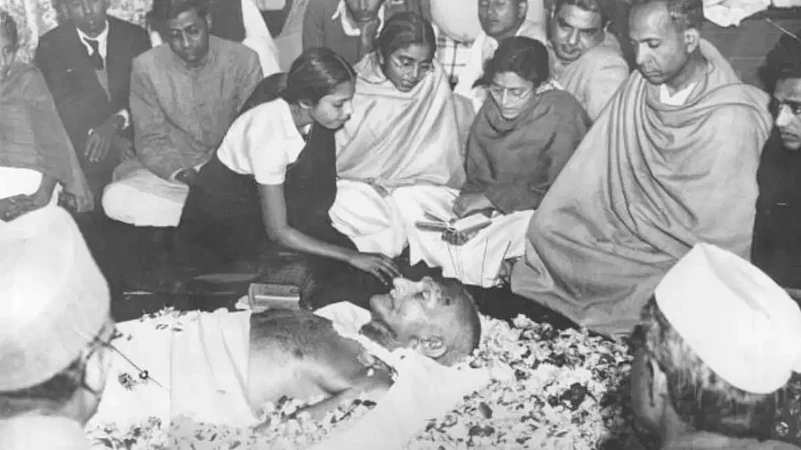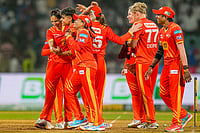Leaders like Mahatma Gandhi, John F Kennedy, Rajiv Gandhi, and Martin Luther King Jr commanded large followings. They had countless admirers but there were also those who did not like them. For them, assassination served as an outlet of their collective or individual frustration with these leaders.
The world has witnessed sporadic attempts on the lives of world leaders throughout history. These include people of the nobility, heads of governments, and leading public figures.
Some of these assassinations had profound impacts. In India, Indira Gandhi’s killing at the hands of her Sikh security personnel led to anti-Sikh riots and Sheikh Mujibur Rahman’s killing in Bangladesh led to the establishment of military rule.
Here are eight instances of assassinations in recent history.
Mahatma Gandhi
Revered as ‘Bapu’ and ‘Father of the nation’, Mohandas Karamchand Gandhi was assassinated on 30 January 1948 in Delhi by Nathuram Godse, a right-wing extremist and member of Hindu Mahasabha. Following the Partition of British India, communal tensions were high and some, including Godse, believed that Gandhi had been too compassionate towards safeguarding Muslim interests.
Against this backdrop, Godse approached Gandhi at the Birla House and fired three shots at point blank range. As Gandhi fell to the ground, Godse was immediately captured by the crowds and handed over to the police.
In May 1948, the Gandhi murder trial began at Red Fort and Nathuram Godse, Narayan Apte, and six others were accused in plotting Bapu’s murder. Godse and Apte were awarded the death penalty and while appeals for commuting their death sentence were later made by Gandhi’s sons, Manilal Gandhi and Ramdas Gandhi, they were rejected and the duo was hanged in Ambala jail on 15 November 1949.
S. W. R. D. Bandaranaike
Soloman West Ridgeway Dias Bandaranaike was the fourth Prime Minister of Ceylon (now Sri Lanka), and was assassinated on 25 September 1959. A Buddhist priest, Talduwe Somarama Thero, fired three shots at Bandaranaike during a public meeting at his house. The PM died in a hospital in Colombo the next morning and his demise led his widow Sirima Ratwatte Dias Bandaranaike to become the world's first female prime minister.
Thero was immediately arrested and following an intensive investigation, the police nabbed six other co-accused. The probe revealed that one of the chief conspirators, Mapitigama Buddharakkitha Thero, plotted the assassination after the PM refused to grant his company a shipping contract, and later a lucrative sugar production licence.
One of the accused, Amerasinghe Arachchige, became a witness during the probe and was granted pardon, while another suspect Vimala Wijewardene was deemed innocent. The Supreme Court trial for the remaining five commenced in February 1961 and a few months later in May 1961, two were acquitted, while Somarama Thero, Buddharakkitha Thero and HP Jayewardena were found guilty and sentenced to death.
However, multiple rounds of appeals and legislative revisions followed which led to a commutation of the two convicts’ death sentence to life imprisonment. Forty-eight-year-old Somarama Thero was the only conspirator who was hanged till death on 6 July 1962. Buddharakkitha died in prison due to a heart ailment in 1967 and Jayewardena was prematurely released in 1977.
John F. Kennedy
The 35th and youngest-ever President of the United States was shot during a presidential motorcade rally in Dallas on 22 November 1963. Texas Governor John Connally, who was in the vehicle with President Kennedy, was also wounded in the attack.
Kennedy was shot by Lee Harvey Oswald, a former US Marine. He was arrested immediately after the incident and charged with Kennedy’s murder. As the trial began, two days later, when Oswald was being shifted to the Dallas police headquarters, he was shot dead by a disgruntled nightclub operator from Dallas.
Kennedy’s assassination opened investigations and both the 1964 Warren Commission report and the 1979 US House Select Committee on Assassinations concluded that Oswald’s three rifle shots killed the President, who was likely “assassinated as a result of a conspiracy”. Besides Kennedy, three other American Presidents, William Kinley, James Garfield, and Abraham Lincoln were also targeted in assassination attempts in 1901, 1881, and 1865, respectively.
Martin Luther King Jr.
Martin Luther King Jr. had been at the forefront of the American civil rights movement that strived to end the racist segregation of African-Americans in the United States. Resultantly, while worshiped by some, he was also ridiculed by those who opposed his efforts.
The African-American civil rights leader and Nobel laureate was fatally shot in Memphis, Tennessee on 4 April 1968 by James Earl Ray, a petty criminal. The assassination was believed to be a part of a larger conspiracy involving the US government but due to lack of evidence, the case was closed prematurely. Ray pleaded guilty in 1969 and was sentenced to 99 years in prison.
Later, however, he recanted his confession and demanded a trial, blaming a conspiracy in King’s assassination. He also attempted to escape from jail multiple times, albeit unsuccessfully. He died in Tennessee State Penitentiary in 1998.
Sheikh Mujibur Rahman
Bangladesh’s first President and later Prime Minister, Sheikh Mujibur Rahman, affectionately remembered as “Bungabandhu,” was killed in a military coup on 15 August, 1975 after a military procession led by ex-Mujib army officials invaded his residence. His family members were also slain in the attack, with his daughter Sheikh Hasina being the lone survivor.
Thirteen army personnel, who backed Rahman’s liberation movement in 1971, were convicted for murdering him and his family members in 1998 and sentenced to death. After the country’s apex court upheld the conviction in 2009, five of them were executed soon after. More recently, in 2020, Bangladesh executed ex-Army Captain and chief conspirator of the coup Abdul Majed.
For over two decades, an indemnity law brought into force by the post-coup government prevented proper prosecution of the conspirators. This was only overturned after Rahman’s daughter, Sheikh Hasina, assumed charge as the Prime Minister in 1996.
Lord Mountbatten
The last Viceroy of British India, also referred to as ‘Dickie’ Mountbatten, was targeted in a bomb blast planted by an Irish national on 27 August 1979. The accused, Thomas McMahon, was a volunteer in the Provisional Irish Republican Army (IRA).
McMahon planted a bomb on Dickie's boat while it was harboured overnight in Mullaghmore Peninsula in County Sligo. It detonated hours later when Mountbatten was onboard with his family. Mountbatten was severely injured by the explosion and was found alive by fishermen, but eventually breathed his last before he could be rescued. The blast also claimed the lives of Mountbatten's young grandson, Nicholas Knatchbull and a crew member, Paul Maxwell.
Soon after, the IRA claimed responsibility for the attack and described it as “a discriminate act to bring to the attention of the English people the continuing occupation of our country”. McMahon was sentenced to life imprisonment but was released in 1998 under the Good Friday Agreement that was signed for lasting peace in Northern Ireland.
Indira Gandhi
India’s first and only female Prime Minister was killed by bullets fired by her own bodyguards Satwant Singh and Beant Singh on 31 October 1984. She received immense criticism and hostility in the aftermath of Operation Blue Star conducted in June 1984.
As part of Operation Blue Star, Indira Gandhi ordered an Indian military operation in the Harmandir Sahib (Golden Temple) at Amritsar, regarded as the Sikh community’s holiest shrine. The operation sought to liberate the Gurudwara from separatist elements including Khalistani leader Jarnail Singh Bhindranwale and his followers. The offensive however led to fatal clashes wherein at least 450 Sikh terrorists were killed, while the Indian army suffered 83 fatalities, besides several being severely injured.
The large-scale loss of life as well as damage to the holy shrine led to mounting public anger towards Gandhi. Soon after her assassination, the two bodyguards were arrested. While Beant Singh’s death is attributed to torture during interrogation in custody, Satwant Singh and his uncle Kehar Singh, who was a co-conspirator, were sentenced to death and hanged in Delhi’s Tihar jail.
Rajiv Gandhi
Shortly after Indira Gandhi’s assassination, her son, Rajiv Gandhi took charge as the Prime Minister. In 1991, Rajiv himself was killed in a suicide bomb attack while he was campaigning in Tamil Nadu for the upcoming elections. 14 others were killed in the explosion on 21 May.
The Sri Lankan rebel outfit Liberation Tigers of Tamil Eelam (LTTE) was held responsible for the assassination, which grew disgruntled with the PM’s role in stationing the Indian peacekeeping (IPKF) forces in 1987 on the island nation to fight the separatist movement and enforce a peace accord.
The apex court had concluded that the decision to target Gandhi precipitated against the backdrop of an interview he gave to a news magazine in 1990 wherein he stated that he would send the IPKF to disarm the LTTE if he returned to power.
Twenty-six people were convicted in the trial but years after the TADA Act was scrapped, the apex court in 1999 upheld the conviction of only seven people and released all others. These included Murugan alias Sriharan, an LTTE operative from Sri Lanka, his wife Nalini who was an Indian citizen, Sri Lankan nationals Robert Pious, his brother-in-law Jayakumar and Ravichandran, along with Indian citizen AG Perarivalan who was charged with supplying a 9-volt battery for the explosive device.
Four of them were sentenced to death and three to life imprisonment, but by 2014, all death penalties were commuted to imprisonment for life. In May this year, the Court invoked its extraordinary power under Article 142 of the Constitution and ordered the release of AG Perarivalan after he served over 30 years in jail, citing his ‘good behavior.’ Earlier this month, the remaining six convicts were also released from prison.


























